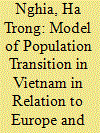|
|
|
Sort Order |
|
|
|
Items / Page
|
|
|
|
|
|
|
| Srl | Item |
| 1 |
ID:
175092


|
|
|
|
|
| Summary/Abstract |
This paper analyses the population transition model for Vietnam, based on Grover’s five stages of population transition. Compatible with the transitional model of Western Europe and other advanced Asian countries, this process in Vietnam has some significant differences: (a) the initial shift or transition of fertility of the population in Vietnam is later than in Asian countries by about 13 years while compared to Europe it is nearly 108 years later; and (b) while the period of initial transition of mortality in Vietnam may not be very different from other Asian countries, it is more than 100 years later than in European countries, especially those in Western Europe. One of the main factors influencing the late transition of Vietnam’s population process is, of course, colonialism and the consecutive wars (1945–1954 and 1955–1975). After 1975, Vietnam’s population was stable as industrialisation and urbanisation led to the development of health services, education and an urban lifestyle, as well as effective population policies.
|
|
|
|
|
|
|
|
|
|
|
|
|
|
|
|
| 2 |
ID:
160819


|
|
|
|
|
| Summary/Abstract |
Fertility is one of the elements in population dynamics that makes a significant contribution towards changing population size and structure over time. In Ethiopia, for the last 10 years the total fertility rate (TFR) has declined slightly from 5.5 to 4.8 children in 2011. But, the TFR in urban areas has increased from 2.4 to 2.6 per 1000 live births. The Bongaarts model was applied to estimate the indices of the four main proximate determinants of fertility. Bongaarts defines the TFR of a population as a function of the total fecundity rate (TF), index of marriage (Cm), index of contraception (Cc), index of postpartum infecundability (Ci), and index of abortion (Ca); this can be written as TFR = Cm × Cc × Ci × Ca × TF. In 2005, the index of married women in urban areas was lower than rural, but it was unfortunately the same in urban and rural areas in 2011. For the last decade, the index of postpartum infecundability had a great fertility reduction effect compared with the contraception index and marriage index in rural Ethiopia. The lower the four indices of proximate determinants, the more fertility will be reduced. As such, the Ethiopian government, international non-governmental organizations and policy-makers must pay attention to increase the prevalence of contraceptive use and educate society to fight against child marriage. Permanent contraceptive use, such as female sterilization, should be promoted; moreover, legal organizations and the community must work together to raise the legal age of marriage to 18 years.
|
|
|
|
|
|
|
|
|
|
|
|
|
|
|
|
|
|
|
|
|